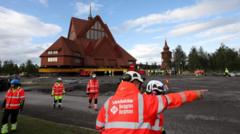Kiruna, a city located 145 km north of the Arctic Circle, is witnessing a historic event as its iconic church—dating back to 1912—is being relocated to avoid the dangers posed by ground subsidence. The vast timber structure, which stands at 35 meters high and weighs 672 tonnes, is moving a distance of 5 kilometers (3 miles) along a prepared road, assisted by giant rolling platforms designed specifically for this operation.
This monumental task began early Tuesday morning, with plans allowing for a maximum speed of 500 meters per hour. Project manager Stefan Holmblad Johansson, who has overseen the meticulous planning and execution of this move, expressed confidence in the operation: “It’s a historic event, a very big and complex operation and we don’t have a margin of error. But everything is under control.”
Ground fissures, a consequence of over a century of iron ore mining beneath the city, prompted the relocation of this landmark. Swedish law prohibits mining under inhabited structures to prevent dangerous collapses, making this move not only urgent but also essential for the city's future viability.
The church's journey is part of a broader initiative—known as the relocation of Kiruna—to move buildings from the old city center to a new area deemed safe. Previously, other landmarks, including notable wooden houses and a clock tower, have faced relocation, but the church's movement stands out as particularly symbolic to many locals. Sofia Lagerlöf Määttä, a culture strategist, shared: "It’s like finally, let’s get it done. We’ve been waiting for so many years."
Care has also been taken to protect the church’s interior treasures during the move, including a significant altar painting by Prince Eugen. The engineering team has opted to leave this artwork and the church's grand organ intact during the transfer, ensuring they are securely housed within as the structure makes its way to the new site.
As Kiruna’s church inches forward, local residents—along with dignitaries, including the Swedish King—are lining the route to witness this spectacle. Swedish television channels are broadcasting the journey live, making it a rare event of communal pride as a piece of history physically transitions into a new era, echoing the memories and cultural significance it holds for those who have cherished it for generations.






















